
Ammanodemātās:
The Festivals of the Wheel of the Year
First Crossquarter (Nov. 1):
 Neo-Pagan name: Samhain Neo-Pagan name: Samhain
Gaulish name: Trinoux Samoni (Three Nights of Samonios)
Samhian is the feast of the dead, the time when our ancestors are closest to us. The tension between Samos and Giamos breaks, the heat of the summer is a distant memory, and the cold of the winter is heralded an all-too-real taste of what is to come.
Traditionally, Samhain was a time of reflection and celebration: the harvest had come in, and there was fresh meat and lots of grain. There was respect and fear of the ancestors who were about at this time, and rituals to remember them and appease them were common.
The modern trappings of Halloween are ever-present now, and those, too, inform our practice. The Grove celebrates Samhain with our longest ritual of the year, dedicated to Cernunnos as the god who holds the opposites apart. I also celebrate by cooking a meal for the ancestors and dining with them.
Winter Solstice (Dec. 21):
 Neo-Pagan name: Yule Neo-Pagan name: Yule
Gaulish name: Rivros
The winter solstice is a dark time, but a time full of hope and newness. The earth has descended into darkness, but at the moment of triumph, the darkness gives way once more to the light, and the momentum swings. It is the dawn on the morning of the winter solstice that assures us that winter cannot and will not last forever.
The ancients would celebrate in halls, or by wassailing between them. There may have been many associations with rebirth, as evidenced by the shaft of light that enters the Newgrange burial mound in Ireland. In Rome, social orders were reversed at Saturnalia.
In secular America, our rituals are mostly focused around family and kindness. Gift-giving is common, as are roaring fireplaces and kisses under the mistletoe. For the Grove and myself, we focus on being together and giving to those less fotunate.
Second Crossquarter (Feb. 1):
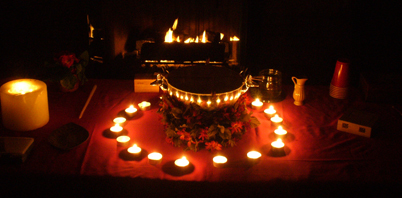 Neo-Pagan Name: Imbolc Neo-Pagan Name: Imbolc
Gaulish Name: Ogranijā
Imbolc is a time of the renewal of the earth, where the bounty of the world returns in full. The animals begin to give birth, the first shoots may begin to appear through the melting snow and ice, and though winter is still holding her grip, the world is obviously changing.
Historically, Imbolc is the time when the sheep begin to lactate, a sure sign that the winter will come to an end. Modern folklore also seeks signs that the winter will come to an end on this day, too: Groundhog Day is February 2nd in the US, and we celebrate a strange ritual where the length of winter is determined by whether a groundhog sees his shadow or not.
To both my Grove and myself, this High Day is one of renewals. We light candles around the Well for Brigando, and call the light back.
Spring Equinox
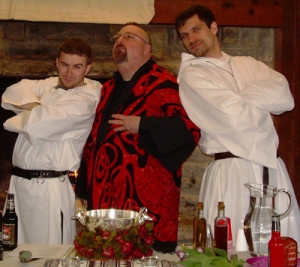 Neo-Pagan name: Ostara Neo-Pagan name: Ostara
Gaulish name: Sonnocingos
The spring equinox is a time of planting, where the ground is thawed and new things can be initiated. It's a time to think about plans for the future, and to gather together all the things you will need for the work you will do in the year to come.
In ancient days, the folk would bring their tools to the priests who would then "charm" them. This charming or blessing would keep those tools in good working order throughout the year, and would thus sustain the lives of the folk through the always dangerous time from planting to harvest.
The Grove celebrates by bringing forth the tools we use in our work and blessing them in the "working" portion of our rite. I celebrate by taking my first spring hikes in the crisp spring mornings.
Third Crossquarter (May 1):
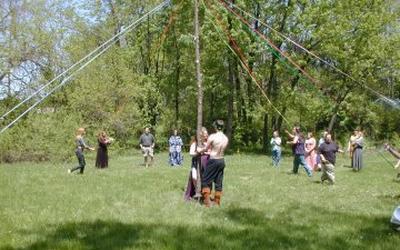 Neo-Pagan name: Beltaine Neo-Pagan name: Beltaine
Gaulish name: Centusamino
Beltaine is a liminal time of the year. Again, the tension between Samos and Giamos breaks, and the cold of the winter has become a lingering memory, while the promise of warm summers arrives in full force.
In ancient days, Beltaine was a time of separation. In Ireland, the women would leave the settlement with the animals while the men would stay and work the fields. This festival began the warring and hunting season, and the health and safety of animals and crops was vitally important: between harvest and planting, fears of sickness are almost tangible.
There is a tradition of Neo-Pagan marriages at Beltaine, but it's firmly modern. The Grove usually celebrates with a maypole dance, and often with a processional through a pair of fires to represent the purification aspects of this High Day.
Summer Solstice
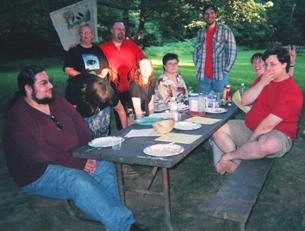 Neo-Pagan name: Midsummer Neo-Pagan name: Midsummer
Gaulish name: Equos
The sun has reached its height on this day, overpowering the darkness and the night. But on the day of the sun's greatest triumph, the sunset brings the first change in momentum in the constant battle of light and dark. After this sunset, the days will get shorter and the nights longer.
Often celebrated by bonfires and music in the ancient world, the concept of the "needfire" in Germanic tribes, which is a fire designed to ward off the plague. Bonfires are a common fixture in the ancient and modern celebrations of this holiday.
Our Grove has always focused this festival on community: there is a definite feeling of togetherness and family that permeates this festival, and we spend it picnicing in the park or at a local community festival. This is a festival of joy in each other that we will always hold dear.
Fourth Crossquarter (Aug. 1)
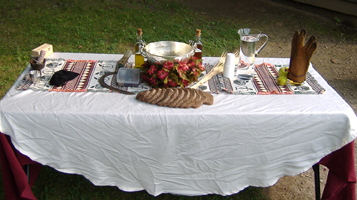 Neo-Pagan name: Lughnassadh Neo-Pagan name: Lughnassadh
Gaulish name: Aidrinijā
This feast is focused on the reaping and harvest traditions. It's a time of much work, and much joy, as the lean summer months are ending and the bounty of fall is expanding. This time of the year is strongly focused on women: their heroism and their strength. It is also focused on marriage and sovergenty.
In Gaul, August 1 was a festival of sovergenty, the marriage of the king to the land. In Ireland, it was the funeral games held for Lugh's foster mother.
Our Grove celebrates the harvest by holding games and crowning a champion, who receives special honour. This festival is a time for me, personally, to look back and see how what was planted in spring came to fruit in the late summer.
Autumnal Equinox
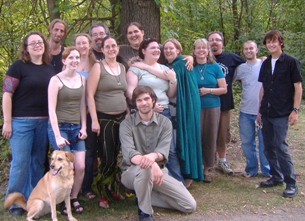 Neo-Pagan name: Mabon Neo-Pagan name: Mabon
Gaulish name: Cantlos
A time of harvests, it is also a time of reflection. As Pagans, we see this as the beginning of the "dark half" of the year, commonly a time when the world begins to change and hibernate. As moderns, this is a time eulogized by many teen-angsty songs as a time of separation from our summer loves, a return to isolation and "real life".
Our Grove celebrates this High Day as our anniversary rite, marking the day that the Grove's spiritual work truly began. In this way, it becomes a recognition of the community we have shared, the things we have worked through, and a time to look forward and focus on the work of the future months, the critical months of Samhain to Beltaine, where that community is most important.
Notes/Sources
For Gaulish names of festivals, I rely heavily on the Outline of Neo Gaulish Religion, v. 7.0, by Ariotanos Iuranantantios. The Outline doesn't entirely match up with the existing scholarship, so I recommend reviewing the Outline in light of scholarship and your own understanding of how best to reconcile a modern calendar with an ancient one.
I also relied heavily on a handout by Sharon Paice MacLeod, entitled, "Oenach Aimsire na mBan: Seasonal Work, Gender Roles and an Early Irish Cycle of Myths," which I received at the 23rd Harvard Celtic Colloquium while attending her lecture.
The photos come from Three Cranes Grove, ADF, and a variety of members and friends have provided them over the years, including Rev. Jenni Hunt (Samhain, Sp. Equinox, and Summer Solstice), Anna Messinger (Imbolc), and Selene Tawney (Beltaine).
Samos and Giamos are Gaulish words that define the general cycles of the Wheel of the Year, which might be described well as a tension between between the light and the darkness. Simply, Samos is the summer light and Giamos is the winter darkness.

Content © 2003-2007, Michael J Dangler
Updated on 08/14/2007. Site Credits / Email Me!
Basic site design from ADF.org
(Yes, I stole it!)
| 


